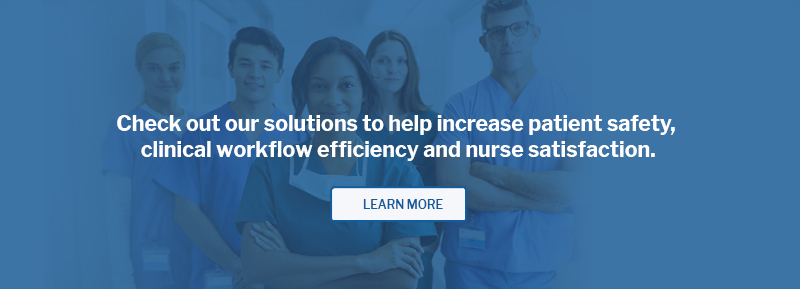Addressing the Nursing Shortage: The Role of Equipment and Technology Providers
Not all angels have wings...some have scrubs.
There’s no denying the critical roles nurses play in healthcare across every medical discipline—from vaccine distribution to front-line emergency triage and everything in between. Most recently, the pandemic shed a bright light on the patience, courage, and utter selflessness of these essential workers. Yet, sadly, over the last few years, the U.S. healthcare system has lost 500K workers.
According to The American Nurses Association (ANA), more registered nurse jobs will be available through 2022 than in any other profession in the United States. According to an article in the Nursing Times, The US Bureau of Labor Statistics projects that more than 275,000 additional nurses are needed from 2020 to 2030. Along with a lack of potential educators, high turnover, and inequitable workforce distribution, the reasons for this crisis include the following:
Right now, the U.S. has the highest number of people over 65 than at any other time in history. In 2029, the last of the baby boomer generation will reach retirement age, resulting in a 73% increase in Americans 65 years of age and older. As the population ages, the need for more nurses increases. Considering that one million registered nurses are also older than 50—many will retire in the next 10 to 15 years. This figure also includes nurse faculty, which means shortages will affect new nurse enrollment and nurse education quality.
As with any profession, people change their minds as their own lives evolve. Nursing is mentally and physically demanding work, so burnout is common. Some learn that the job is not what they imagined. And for others, the demands of their families take them away from nursing—either temporarily or permanently. Currently, the national average for turnover rates is 8.8 % to 37.0%, depending on geographic location and nursing specialty.
Healthcare workers are at high risk of violence, with between 8% and 38% suffering some form of violence in their careers. This includes emotional or physical abuse in what are already extremely stressful circumstances. As one might expect, emergency department and psychiatric nurses are at a higher risk. And the most common form of violence was verbal—usually in the form of being spoken to by a person using loud vocal tones.
Support for current members of the workforce and up-and-coming nurses is vital on so many levels. As part of an industry serving healthcare workers and patients, we must do everything possible to ensure that we meet today’s demands while also addressing future needs. Our best defense against dangerous shortages is through key tools that make nursing an attractive and sustainable career for more people. At TouchPoint Medical, we are committed to leading this charge, delivering products that are easy to learn/use while delivering exceptional functionality.
Managing and dispensing medication safely and accurate is a critical day-to-day task that comes with unique challenges, especially as the demands on nurses continue to increase. A scary 46.8% of nurses have committed a medication error in the past year according to Bradley University. Lack of education, illegible records, fatigue, and false calculations all contribute to this statistic. Staff shortages further complicate matters by asking that available nurses take on even more—increasing the risk of fatigue-related mistakes.
TPM’s medDispense Automatic Dispensing Cabinets (ADCs) powered by medLogic™ software platform deliver increased efficiency and flexibility for nursing teams at a variety of facilities, increasing patient safety in the process. Because they’re exceptionally easy to learn and use, they reduce the time clinicians need to get up and running. Experienced and new-to-the-job nurses alike appreciate the friendly graphical user interface, which provides stress-free operation and time back to focus on patient care.
Software modules on these cabinets also include NurSync™ for remote medication queuing, medGuard™ for controlled substance inventory management, and PharmacyCenter™ for reporting and system administration. All specifically address daily responsibilities while shoring up patient safety through better communication, control, and accuracy. Other key features that improve daily usability for nurses include:
- Lot number stocking that enables key identifiers to be assigned to medication batches, facilitating drug manufacturing inventory control and tracing of adverse incidents.
- Configurable medication search functions that allow facilities to make searching for commonly used medications easier and faster for on-staff nurses.
- On-demand stock reports generated by items/medications give nurses the power to quickly see what’s available and take necessary steps to obtain the drugs their patients need.
- FIFO stocking workflow takes the guesswork out of first-in, first-out distribution, saving time and headaches during busy rounds.
- Barcode stocking provides a simple way for nurses to quickly stock and track incoming and outgoing medications.
- Support for multi-item kits makes accessing supplies for specific procedures and protocols easier and more accurate.
- Fractional dose stocking and dispensing help reduce waste.
The peace of mind that comes with knowing that staff members are backed up with these advanced features all designed specifically to prevent costly (and potentially deadly) errors is invaluable—for patients, nurses, and the healthcare system at large. Making them available is also a great way to improve job satisfaction, which happens when staff members feel supported by management. As a result, we increase the likelihood that others will choose, continue and excel at their work in nursing.
For all the ways that our ADCs add important fail-safes into the medication management equation, TouchPoint Medical’s models are designed to reduce the physical tolls of nursing. Ergonomically designed equipment plays a large role in increasing on-the-job satisfaction, safety, and comfort for nurses in all healthcare settings. (learn more about ergonomic essentials) With care and attention to purposefully designed products, any facility can help decrease the risks of developing CTDs and other workplace injuries.
The very best ergonomic equipment features adjustable arms, desk/workstation heights, and configurations that enable standing or sitting while working. TPM’s medical workstations, carts, stands, and mounts help nurses deliver the best patient care while optimizing workflow, achieving security goals, and reducing staff fatigue through ergonomic solutions. They incorporate features that are proven to make standing, sitting, and moving as safe and comfortable as possible. All of our equipment is designed to adapt to a variety of users and spaces—allowing nurses the freedom to work in ways that suit their individual needs. And we are pleased to offer a team dedicated to helping our clients select and implement all new equipment. Workplace safety and comfort through ergonomic equipment is yet another step towards showing true care for nurses—encouraging their success today and into the future.
And finally, to bolster confidence, encourage education and promote faster onboarding of new nurses, TPM offers a robust online Nursing Resource Center with insights, trends, and advancements in the field. The information included is designed to increase patient safety, clinical workflow efficiency, and nurse satisfaction. It’s a simple and powerful way for new and veteran nurses to stay in the know. Nurses can sign up to receive updates by going to https://www.touchpointmed.com/nursing-resource-center to sign up.
- https://www.aacnnursing.org/News-Information/Nursing-Shortage-Resources/Impact
- https://nursejournal.org/articles/post-pandemic-nursing-shortage/
- https://www.ncbi.nlm.nih.gov/books/NBK493175/
- https://onlinedegrees.bradley.edu/blog/the-nursing-shortage-and-how-it-will-impact-patient-care/



